
Paul Gustave Louis Christophe Doré
(★ 6 January 1832, Strasbourg, France;
† 23 January 1883, Paris, France)
See comments for a video about Master Illustrator Gustave Doré, from the extensive and informative series by Pete Beard on the great Golden Age illustrators. Well worth exploring.
漢清講堂289 續《在永恒之門》- 插畫家古斯塔夫·杜雷(Gustave Doré) HC/John Walsh
從Gustave Doré 多雷(1832 – 1883) 到《梵谷:在永恆之門》(2018)
***
Gustave Doré, Don Quixote. 1863 Paris Hachette edition
𝐆𝐮𝐬𝐭𝐚𝐯𝐞 𝐃𝐎𝐑𝐄́ [
 1832 - 1883]
1832 - 1883] Bradamente embracing Ruggiero.
1879.

隱身的天才:古斯塔夫多雷傑作精選集
ISBN13:9787521754575
中信出版社
作者:(法)阿利克斯·帕雷; 瓦萊麗•敘厄爾-埃梅爾
出版日期:2023/04/14
裝訂/頁數:精裝/480頁
開本:大16開
版次:一版
內容介紹
分別來自羅浮宮和法國國家圖書館的兩位法國編輯從多雷的上萬幅插圖作品中精選出那些極其重要、視覺效果甚是強烈、很能代表他藝術風格的作品,兩人分工合作,前者帶讀者徜徉在多雷藝術作品背後的文學幻想和文藝圈八卦裡,後者娓娓娓道來多雷藝術作品背後的文學幻想和文藝圈八卦裡,後者娓娓道來多雷版的高超技製作高超技。讀者會感覺自己站在連結古典和前衛的橋樑之上,一起沉浸在多雷的永恆魅力中吧!
Books, Illustrations & Magazines : The Golden Age 在 𝐆𝐮𝐬𝐭𝐚𝐯𝐞 𝐃𝐎𝐑𝐄́ [
 1832 - 1883] 相簿中新增了 1 張相片。
1832 - 1883] 相簿中新增了 1 張相片。𝐆𝐮𝐬𝐭𝐚𝐯𝐞 𝐃𝐎𝐑𝐄́ [
 1832 - 1883]
1832 - 1883] Bradamente embracing Ruggiero.
1879.
Ruggiero (character) - Wikipedia
https://en.wikipedia.org › wiki › Ruggiero_(character)
Ruggiero is the subject of two possible prophecies. His first possible fate is to convert to Christianity, marry Bradamante and sire a line of heroes that ...
Religion: Islam, then Christianity
First appearance: Orlando Innamorato
Story · Depictions
Bradamante - Wikipedia
https://en.wikipedia.org › wiki › Bradamante
In 1582, French dramatist Robert Garnier wrote a tragicomedy named Bradamante that further develops the love story between the heroine and Roger (Ruggiero).
First appearance: Orlando Innamorato
Religion: Christianity
'The Divine Comedy' (Inferno, Canto 1) Engraving by Gustave Doré, 1860s
39
****
Van Gogh Museum
 ‘…from the people for the people’ – Van Gogh wanted to produce drawings that appealed to the lower classes, and that they could afford.
‘…from the people for the people’ – Van Gogh wanted to produce drawings that appealed to the lower classes, and that they could afford. He wanted to offer comfort with his art. Do you think he succeed in doing this with this drawing?
 Vincent van Gogh, At Eternity's Gate (1882)
Vincent van Gogh, At Eternity's Gate (1882)The Museum Without Walls/Le Musée Imaginaire
7月28日下午10:00 ·
MWW Gallery of the Day (9/7/21)
Doré Illustrations I: Coleridge, Cervantes, Poe
https://www.facebook.com/media/set/......





+196
The Museum Without Walls/Le Musée Imaginaire 在 Doré Illustrations I: Coleridge, Cervantes, Poe 相簿中新增了 200 張相片。
2015年10月12日 ·
Gustave Doré (1832–1883) was the foremost and most prolific illustrator in the nineteenth century's Golden Age of Book Illustration, and one of the greatest draughtsmen ever. This first of several MWW galleries devoted to him presents all his illustrations for three classic works of literature: Samuel Taylor Coleridge's "The Rime of the Ancient Mariner," Miguel Cervantes' "Don Quixote," and Edgar Allan Poe's "The Raven."
For those wishing to revisit or experience for the first time the literary works themselves while viewing the images, the corresponding text of both the Coleridge and Poe poems is provided in the commentary section. (You may have to click "See More" to access all of it.) For the Quixote illustrations either the corresponding text (in an English translation) or a plot summary of the relevant chapter is provided.
Future MWW Doré galleries will present his illustrations for Dante's "Divina Commedia," the Bible, Milton's "Paradise Lost," works by Shakespeare, Rabelais, Tennyson and others.
MWW Gallery of the Day (7/28/20)
Doré Illustrations II: The Bible
https://www.facebook.com/pg/TheMuseumWithoutWalls/photos/?tab=album&album_id=1064581186980583
+240
The Museum Without Walls/Le Musée Imaginaire 在 Doré Illustrations II: The Bible 相簿中新增了 244 張相片。
2017年3月1日 ·
In the Western World, which has seen many books come and go over the last two millennia, there is one which can claim to stand head and shoulders above the rest when it comes to cultural pedigree and artistic influence -- the Christian Bible. Its very name is derived from the Greek word for "books." It was the first to come off Gutenburg's printing press, and in the 563 years since has been reprinted, re-issued in new editions, and translated and re-translated into more languages than any other book. The stories it contains have been depicted in more works of art than any human could possible view in a lifetime. And, not surprisingly, more illustrated editions of it have been published than any other book in history. Here, we present the complete set of the most celebrated of all Bible illustrations, those by the French artist Gustave Doré (1832-1883).
Doré had already achieved considerable success as an illustrator of works by Byron, Shakespeare and Cervantes, when he was commissioned by French and English publishers to do a series of wood engravings to adorn "La Grande Bible de Tours," a large folio edition published in two volumes simultaneously by Mame in Tours, France and by Cassell and Company in England in 1866. The 241 that he executed not only secured his reputation as France's foremost illustrator, but also set him on the path which would lead him to being proclaimed the greatest of all time.
This series of illustrations comprises 139 plates depicting scenes from the Old Testament, 21 from the Apocrypha (deuterocanonical books), and 81 from the New Testament. One will, of course, find none illustrating passages from the more prosaic biblical books like Deuteronomy or Leviticus, nor even any from the poetical Psalms or didactic Epistles of Paul. Almost all of them illustrate oft-depicted dramatic scenes from Genesis, Exodus, the Four Gospels, the Book of Revelation, and the like. To give the non-biblical scholar the necessary context to appreciate each picture, we have included the relevant biblical text from the 1769 King James Version in the commentary section. (You will have to click "See More" to access these.)
See also this previous MWW gallery devoted to this artist:
* Doré Illustrations I: Coleridge, Cervantes, Poe
Future MWW Doré galleries will present his illustrations for Dante's "Divina Commedia," Milton's "Paradise Lost," works by Shakespeare, Rabelais, Tennyson, Charles Perrault and others.
要點 London: a pilgrimage、 Don Quixote、老水手行等書
https://www.wikiart.org/en/gustave-dore
Gustave Dore - 758 paintings, illustrations, drawings and prints
多雷插圖本:聖經故事、神曲、巨人傳、拉封丹寓言詩、國王的敘事詩、老水手行、忽必烈汗、克麗斯德蓓、孤獨中的憂思、夜鶯......*缺莎士比亞、巴爾札克、London: a pilgrimage...
博客來網站
Doré's later work included illustrations for new editions of Coleridge's Rime of the Ancient Mariner, Milton's Paradise Lost, Tennyson's Idylls of the King, The Works of Thomas Hood, and The Divine Comedy. Doré's work also appeared in the weekly newspaper The Illustrated London News
London: a pilgrimage with 180 engravings.
Blanchard Jerrold (1826–1884) Gustave Doré (1832–1883)
Blanchard Jerrold (1826–1884) joined forces with the famous French artist Gustave Doré (1832–1883)
Paul Gustave Doré 1832~83
Photograph by Nadar, 1867
《梵谷:在永恆之門》(英語:At Eternity's Gate)2018
Expert claims to discover 65 'lost' Van Gogh sketches,
***
http://www.gutenberg.org/files/44428/44428-h/44428-h.htm
THE DAYS OF CHIVALRY
OR THE LEGEND OF CROQUEMITAINE
By Ernest Louis Victor Jules L’Epine
Freely Translated From The French of L’epine by Tom Hood.
Illustrated With 177 Designs on Wood
BY GUSTAVE DORÉ.
CHAPTER VIII. THROUGH THE FORESTS.
THE sun sank down in a flood of purple, the birds were chanting their vespers.
“Come on, Croque-Miton-Mita-Mitaine!” cried the girl. “I would not stir from the spot for the spurs of knighthood.”
The sky changed from gold to pale blue, from pale blue to violet, from violet to indigo, from indigo to black. A thousand stars peeped out to see what was going to happen. A waning moon climbed slowly up the heavens, shedding a feeble light and yellow, as if smitten with fever. The air became cooler, a gentle breeze began to stir the foliage, covered with the dust of day, and to awaken it to its morning toilet. Every sound was hushed, except the rustle of the leaves. The grass had growm so thick and long, Mitaine scarcely knew where to set her foot. She was not afraid, and yet, as she advanced, her thoughts became more grave. To be self-collected in danger is one of the signs of courage. A coward loses himself in the presence of peril.
“What am I about to meet with yonder? What obstacles shall I fall in with? I have always heard my royal godfather say that there is nothing one cannot overcome by courage, skill, and perseverance; it he spoke the truth, I have nothing to fear. This Croquemitaine, perhaps, is, after all, only a robber chief, profiting by the public panic to pillage the passers-by. The passers-by?—but nobody does pass by, and, as a rule, people render pleasing, rather than terrible, the paths that lead to a snare. Pshaw! we shall soon see!”
All her past life came back to Mitaine’s recollection. She seemed as if she should feel less solitary when surrounded by memories of those she loved. She seemed to hear friendly voices. “Be prudent,” whispered her mother.
“Be resolute!” said Charlemagne.
“Be bold!” said Roland.
Thus accompanied, she pushed on with firmer tread, and halted not until she reached the border of the forest. As she entered it, her foot slipped upon some round slimy object, and a snake wound itself round her leg. “So the shame is beginning,” said Mitaine.
There is room in the human heart for Prudence and Courage, they live together like good neighbours, and it would give you, my young friends, a very false idea of bravery to suppose that it cannot exist in company with caution.
Mitaine had put on a suit of mail, and she congratulated herself on wearing her gauntlets, as she stooped down to seize hold of the reptile. She grasped a round and flexible object, and was about to crush it under her heel, when she discovered that what she had taken for a serpent was only a creeper, which broke in her hand. For an instant she felt ashamed.
“This is the’ result of all the stories I have been so long listening: to about this absurd castle. If people had not tried to frighten me, I should not even have stooped down.” And she continued her route.
The moon flung her rays over the forest, and Mitaine beheld in the distance a number of white menacing shapes. Some had burst their shrouds, and allowed their skeleton forms to be seen, clattering at every breath of air; others displayed fearful wounds, in which the weapons yet remained; fleshless arms stretched towards her, and the wind bore to her indistinct and threatening murmurs. She allowed herself to be betrayed into a gesture of alarm; immediately the spectres shook their dishevelled hair, waved their arms, and began to move towards her. She saw them approaching in countless numbers, with menacing aspect and hollow meanings.
“By Roland!” said she, “I believe I’m a little frightened. My godfather would blush for me if he knew it.” She drew her sword, and rushed on.
Hardly had the sense of alarm left her, when the appearance of all she saw was changed. The spectres vanished, and Mitaine saw before her only a few bleached tree trunks, on which the moon shed its rays. Instead of wounds, she saw inequalities of the bark; instead of outstretched arms, she saw branches; instead of unkempt locks, leaves; while in the place of threatening murmurs she heard only the wail of the wind.
“I’m evidently growing foolish,” said she to herself; “I have lost my head, and my brain to-night is full of spectres. I must not let myself be caught again.”
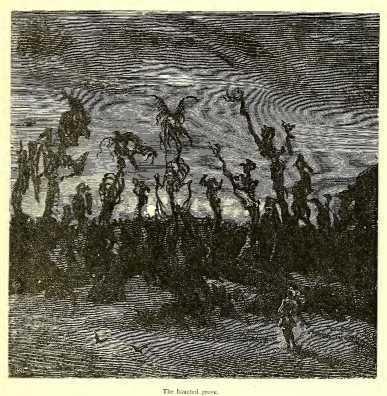
Original Size -- Medium-Size
Scarcely had the thought passed through her mind when she felt herself caught by the leg; this time there was no illusion. She turned round quickly, and saw with alarm a grim shape, which struggled out of the earth, and flung itself upon her. At the foot of every tree she could distinguish like forms buried in the earth breast high, and writhing in agony.
Mitaine strove, but in vain, to release her leg; the shape clung to it, and its head seemed about to seize her in its jaws.
“Reality or spectre—dead or alive—I will try how you will take this;” and she struck fiercely at it with her sword. The blow fell upon the root of a tree.
“How is it that I did not see this at once? I shall never forgive myself this foolish fear. I must admit, Master Croquemitaine, that your jokes are anything but pleasant. Still, I hope you will give me something more serious to do before long, or I shall cut but a sorry figure when I come to relate my adventures.”
Observe, my children, that it is almost always thus in life: out of a hundred things which terrify you, at least ninety-five will only make you smile, if you look them boldly in the face.
The sky had gradually become covered with clouds; large drops of rain began to fall; in the distance the thunder rumbled, but so faintly, that it seemed only like the snoring of an elephant or a hippopotamus.
“The greatest danger I run is that of catching cold. The rain has already begun, and who can tell when I shall reach the Fortress of Fear? This coward of a Croquemitaine has so well concealed his abode, that one might just as well look for a pin at the bottom of the sea.”
A terrific clap of thunder was the only answer she received, and the glare of the light allowed her to distinguish at a short distance the castle, which was perched, as if balanced, on the extreme point of a mountain of eccentric form.
“So this, then, is the precious jewel which they have taken such pains to conceal from all eyes. By my faith! they were right to conceal it, for it appears to me the most hideous in the world.”
Mitaine pushed forward. For a long time she followed the course of a ruined wall, when suddenly a flash of lightning cleaving the heavens enabled her to discover a horrible monster grazing at her from its crest. It resembled the skeleton of a horse, combined with those of an ostrich, a whale, and a giraffe. Its enormous head was supported by a disproportionately long neck, and its two claws, armed with immense talons, were seeking on the top of the wall for some point of vantage whence to leap upon her.
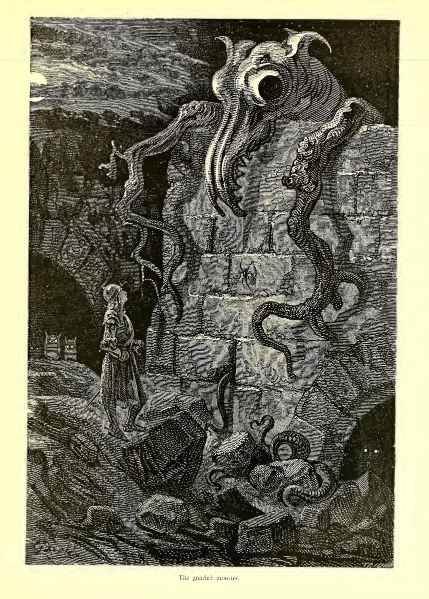
Original Size -- Medium-Size
Mitaine, taken by surprise, sprang back twenty paces; the monster took as many in advance. She sank upon her knee as it drew near, and felt its hot breath blowing upon her.
“By the Shrine of St. Landri! I am acting like a child, and show myself little worthy to follow Charlemagne and Roland to battle.”
She sprang up; the monster immediately recoiled.
“Will nothing teach me wisdom? Every obstacle that I meet boldly disappears, and yet I allow myself to be stopped by this vile form;” and she gave the wall a vigorous kick. The stones fell crumbling, and dragged with them a number of creepers and brambles a century old, breaking a poor harmless tree which had stood for ages, with its branches resting on the wall. Mitaine shrugged her shoulders, and moved on, saying, “As I expected!”
In a few minutes she found herself in the presence of a more serious obstacle. Before her rolled a torrent, which carried down in its rapid waters huge blocks of stone, as any other stream would carry down logs. This new barrier it was not easy either to overcome or avoid. The night was dark, and the moon faint and pale, and half hidden in masses of cloud. It seemed rather like a dying watch-fire than a luminary of the first magnitude. The water of the torrent gleaming in this half light rushed by with formidable violence, and Mitaine felt her brain swim whenever she looked at it. She hurried up and down the bank, seeking in vain for a means of crossing. The lightning, as if to confuse her, redoubled its intensity, and showed her the castle situated at a short distance on the further shore. At length, however, she discovered a tree which lay across the gulf. Every wave as it passed had washed away a portion of the bank; the tree, half uprooted, had held its own well for a time, until at last, weary of the struggle, it had suffered itself to sink to the ground.
Mitaine contemplated this means of crossing not without apprehension. Tremblingly she placed her foot upon the trunk; it shook and rocked. She hesitated, and as her hesitation increased, so the tree became more shaky and uncertain.
“What!” said she, impatiently; “am I so short a distance from my object, and must I draw back because the passage is not quite safe? No! it is fear that makes me awkward; every day I accomplish things far more difficult than this.”
She set her foot resolutely on the trunk, and found, to her surprise, that it grew firmer as she went on.
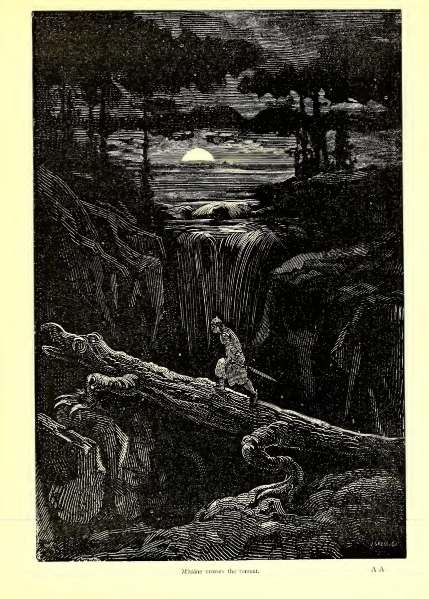
Original Size -- Medium-Size
“Why, I am on a wooden bridge,” said she, when she got half-way over. “Nay, indeed, it’s a fine stone bridge,” she cried, as she reached the farther shore.
Of a truth, my children, fear doubles the importance of most obstacles, for it deprives us of half die faculties which should assist us to overcome them. Take away the ape’s intrepidity and give it to man, and man will become as agile as the ape.
Mitaine saw before her but one road, and set out resolutely along it’ although it wras so narrow that she brushed the rock on either side with her shoulders. It was, in fact, less a path than a cleft in the mountain side. She pushed forward on tip-toe, wondering a little what she should find at the other end of this burrow. Suddenly her head encountered an obstacle, and she discovered that the passage had become so low, that she must stoop to continue her path.
“Do they want to bury me alive?” The thought made her hair bristle; and not without reason, I can assure you, for she was in utter darkness, with hardly a breath of air, and every instant she felt the four walls closing in.
“Do your best, Croquemitaine; it shall never be said that I turned back, when I had got so close to you.”
She was now compelled to continue her progress on her hands and knees. “Yu will get nothing by it; I will pay you for this when I meet you.”
The ceiling was now so low, that she was obliged to drag herself along the ground. “If there be room for a mouse, I’ll get through, never trust me!”
At last, she saw with joy a gleam of light, a few paces further on. This feeble ray gave her fresh courage, and she struggled on by dint of nails, knees, and feet so well, that in a few seconds she had reached the outlet. She was about to breathe again, to live again, to move freely! one more effort, and she would be at liberty! She perceived that the opening at the end of the passage was guarded by a strange sort of grating.
“Well, this complicates the situation! I should be curious to know what my long-bearded godsire would do, if he found himself on all fours in this mole-run before these bars. Assist me to get out of this, St. J ames, and I will offer up to you a prayer of gratitude.”
Mitaine made another movement to approach still nearer to the grating; she was about to take the bars in her hand, when she perceived there was nothing before her but a spider’s web.
“Thanks, St. James! you have saved me from a terrible danger.”
But now the spider came down into the middle of his web to defend his stronghold, and it was with no common insect that she had to deal.
Picture to yourselves a body as big as your two fists, bloated and hairy; legs by the dozen, vying with each other in agility and flexibility, with two pinchers like those of a scorpion, and eyes that gleamed in the dark.
If Mitaine had had the free use of her limbs she would not have taken much notice of such a trifle; but you must remember that she was lying flat upon the ground, hedged in on all sides as close as if in a coffin, and that she could only fight the creature by butting at it with her head. The spider, taking advantage of her hesitation, set about repairing its net, adding thread to thread with frightful rapidity.
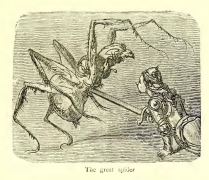
Original Size -- Medium-Size
“It is worth one’s while to be the godchild of an Emperor, the daughter of a knight, the friend of a hero, and, above all, a favourite of St. James, in order to run away from a spider. Mountjoy, St. Denis! let’s charge the foe!” She lowered her head, closed her eyes, and pushed her way on. The web broke; she felt her opponent glide over her shoulder, and run along her back. She immediately pressed herself with all her force against the roof, heard a sound like the breaking of an egg, and stepped forth mistress of the field. With what joy did she find herself in the open air! How did she rejoice in the rain that beat on her face and the whirlwind, whose violence tore up even the stones in her path!
Before her rose the Fortress of Fear.
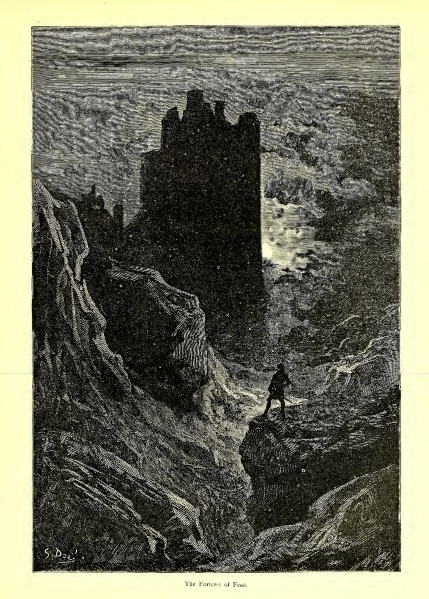
Original Size -- Medium-Size
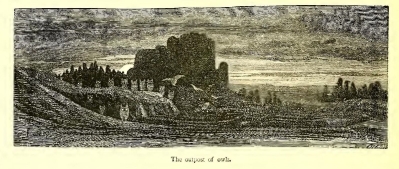
Original Size -- Medium-Size
Expert claims to discover 65 'lost' Van Gogh sketches,
Expert claims to discover 65 'lost' Van Gogh sketches.
In an extraordinary statement, the Van Gogh Museum in Amsterdam argued the sketches were not by the artist, calling them mere “imitations” containing topographical errors, strange provenance and none of his characteristic style.
1989/92
n
English: Newgate Exercise yard by Gustave Dore , from ‘London : A pilgrimage’ by Gustave Dore and Blanchard Jerrold 1872
1890 vincent
簡介Honoré Daumier 1808-79 奧諾雷·杜米埃
仿Honoré Daumier
WOOD BLOCK
拉伯雷(F. Rabelais)《巨人傳》(Gargantua et Pantagruel)
http://www.gutenberg.org/files/1200/1200-h/1200-h.htm
Gustave Doré
1832~83
Rabelais' "Gargantua" (English translation)
Pantagruel. Gargantua and Pantagruel, translated by Sir Thomas Urquhart and illustrated by Gustave Doré.
Les Contes Drôlatiques百滑稽的故事
艶笑滑稽譚
1832~37
Dore 1855
Les Contes Drôlatiques
GUSTAVE DORE ~ THE TEMPEST
1860
La Confusion des langues, par Gustave Doré.
Doré’s depiction of Merlin’s midnight procession,
from the 1863 Paris Hachette edition —
La Danse du Sabbat ~ ca.1870
La Danse du Sabbat ~ ca.1870 Attr. to Gustave Doré, or Émile Bayard
a victorious Saladin, by Gustave Doré
Leviathan
Drawing of Berlioz conducting a choir by Gustave Doré,
published in Journal pour rire, 27 June 1850
https://www.youtube.com/watch?v=P5FTqF0QMUA&t=3s
The Angels In The Planet Mercury, Gustave Dore ,1890
Gustave Doré
The Wolves and The Sheep, Gustave Doré, 1867
信天翁導船入南極冰洋
The Rime of the Ancient Mariner,
6th
Gustave Doré
Samuel Taylor Coleridge died #onthisday in 1834. His supernatural epic The Rime of the Ancient Mariner, about the perils that follow after a mariner shoots an albatross, may have been inspired by James Cook’s polar expeditions, and that of other explorers http://bit.ly/2uN3ZGl
Image from The Ancient Mariner illustrations by Gustave Doré (1875.b.5.)
british
生死之間與死神玩骰子
14thT
"A Celestial Light" : Gustave Doré
From ''Little Red Riding Hood''
- Fall of the Rebel Angels
Andromeda, 1869,
Chimei Museum,
Portrait of Cervantes from the 1738 London Tonson edition
Portrait of Cervantes from the 1738 London Tonson edition, designed by William Kent and engraved by George Vertue
Doré’s depiction of the windmill scene — Source.
Gustave Doré’s depiction of Don Quixote
Gustave Doré’s depiction of Don Quixote amid his fantasies of chivalric romance, the frontispiece to the 1863 Paris Hachette edition
(A Midsummer Night’s Dream, 1870/ Gustave Doré; 1832-1883)
Gustave Doré et Héliodore Pisan
« Et on acheva de laver Don Quichotte » matrice inachevée, c. 1860
gouache sur bois
BnF, réserve du département des Estampes et de la photographie
depicting Don Quixote and Sancho Panza astride their steeds
Title page to the 1620 London Blount edition,
Title page to the 1620 London Blount edition, depicting Don Quixote and Sancho Panza astride their steeds
Depiction of the windmill scene
from the 1648 Frankfurt edition
Depiction of the windmill scene from the 1648 Frankfurt edition
Frontispiece to the 1687 London Hodgkin edition
The allegorical portrait of Cervantes from the 1738 London Tonson edition, designed by John Vanderbank and engraved by Gerard van der Gucht — Source.
Vanderbank’s version of the goatherd scene, from the 1738 London Tonson edition — Source.
José del Castillo’s idea of the scene in which Don Quixote gets beaten by mare herders, from the 1780 Madrid Ibarra edition — Source.
Robert Smirke’s smaller vignette of the penance scene — Source.
Robert Smirke’s full page illustration of the trouserless Don Quixote during the penance scene — Source.
芹沢銈介1895~1984
1937
『絵本どんきほうて』(1937)
Edward Hopper . Don Quixote. 1899, on Illustration board, Whitney Museum of American Art .
Gustave Doré (1832–1883) was the foremost and most prolific illustrator in the nineteenth century's Golden Age of Book Illustration, and one of the greatest draughtsmen ever. This first of several MWW galleries devoted to him presents all his illustrations for three classic works of literature: Samuel Taylor Coleridge's "The Rime of the Ancient Mariner," Miguel Cervantes' "Don Quixote," and Edgar Allan Poe's "The Raven."
For those wishing to revisit or experience for the first time the literary works themselves while viewing the images, the corresponding text of both the Coleridge and Poe poems is provided in the commentary section. (You may have to click "See More" to access all of it.) For the Quixote illustrations either the corresponding text (in an English translation) or a plot summary of the relevant chapter is provided.
Other MWW Doré galleries present his illustrations for Dante's "Divina Commedia," the Bible, Milton's "Paradise Lost," works by Shakespeare, Rabelais, Tennyson and others.

沒有留言:
張貼留言